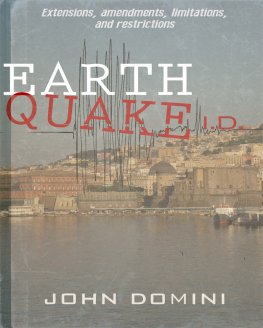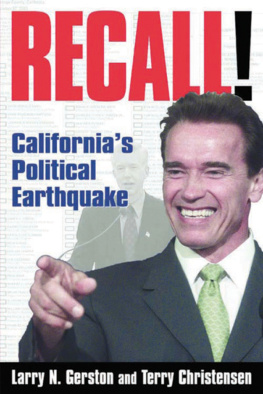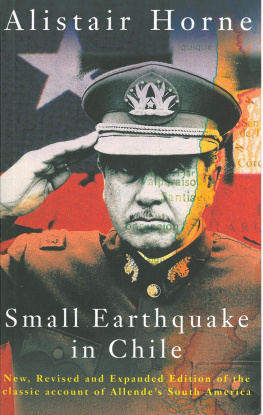Routledge Revivals
The Indian Earthquake
First published in 1935, this book provides a comprehensive overview of the 1934 Nepal-Bihar earthquake, giving a background to the earthquake zone, describing the event itself and surveying the ensuing devastation. The author also looks at the governments actions and the response of Indias other states as well as the religious and social dimension to the reaction exemplified by Mahatma Gandhi. The book examines how the earthquake was compounded by a severe flood that occurred shortly before, how preparations for the monsoon season were made in an attempt to limit further destruction and the subsequent recommendations for more earthquake resistant urban planning.
The Indian Earthquake
C.F. Andrews
First published in 1935
by George Allen & Unwin
This edition first published in 2016 by Routledge
2 Park Square, Milton Park, Abingdon, Oxon, OX14 4RN
and by Routledge
711 Third Avenue, New York, NY 10017
Routledge is an imprint of the Taylor & Francis Group, an informa business
1935 C.F. Andrews
All rights reserved. No part of this book may be reprinted or reproduced or utilised in any form or by any electronic, mechanical, or other means, now known or hereafter invented, including photocopying and recording, or in any information storage or retrieval system, without permission in writing from the publishers.
Publishers Note
The publisher has gone to great lengths to ensure the quality of this reprint but points out that some imperfections in the original copies may be apparent.
Disclaimer
The publisher has made every effort to trace copyright holders and welcomes correspondence from those they have been unable to contact.
A Library of Congress record exists under LC control number: 41013762
ISBN 13: 978-1-138-21185-8 (hbk)
ISBN 13: 978-1-315-45161-9 (ebk)
The
INDIAN EARTHQUAKE
by
C. F. ANDREWS
FIRST PUBLISHED IN 1935
All rights reserved
PRINTED IN GREAT BRITAIN BY
UNWIN BROTHERS LTD., WOKING
DEDICATED
TO MY FRIEND
RAJENDRA PRASAD
WITH DEEP AFFECTION
Out of the great tragedy that has overwhelmed us, we earnestly hope that some good may permanently endure in the shape of a united Nation, joined together in common sorrow and common effort to overcome it, having faith in one another.
STATEMENT BY THE CENTRAL RELIEF COMMITTEE
February 3, 1934
THE profits derived from the sale of this book will be given to the relief of those who have suffered from the great earthquake and from the floods which followed during the monsoon. The manuscript has been held over in order to include, while I was on the spot in India, an account of the damage wrought by the floods, which has been hardly less serious than that already done by the earthquake itself.
In writing about the earthquake I have used freely material published in India, both in the different reports of the Central Relief Committee and also in the Statesman Earthquake Report. I would gratefully acknowledge my debt to these, and also to a lecture delivered by Sir Edward Pascoe, on The Indian Earthquake, before the Royal Society of Arts.
The manuscript, which I had prepared before reaching India, has been revised by my friend, Rajendra Prasad, Chairman of the Relief Committee, while I have stayed with him at Patna and Wardha. Other friends in India have helped me in a similar manner.
May I express a hope that this book will find its way into public libraries where the poor may read it, who cannot afford to buy copies of their own, and that it may also be read, through translations, in European countries which have a deep sympathy with the East? The village people in India, who suffered, are the poorest in the world; and the poor in other countries will be able to understand and feel their sufferings most keenly.
Any help for the sufferers should be sent direct to the Treasurer, Earthquake Central Relief Fund, Patna, India.
C. F. ANDREWS
PATNA, 1934
CONTENTS
THE INDIAN EARTHQUAKE
i
THE principal earthquake shock, which did such damage to the land in North Bihar and destroyed thousands of human lives, occurred at 2.15 p.m. on January 15, 1934.
Preliminary tremors had already warned people of the imminent danger before the fatal shock came. There was everywhere an immediate rush into the open. Only where, in the towns, the streets were narrow was the number of deaths large. While thousands perished (for the worst shocks covered more than fifteen thousand square miles), there were many marvellous escapes.
It is hardly possible to describe in writing the horrors of those few moments for all those who were in the earthquake zone itself. The solid ground was rocking to and fro beneath their feet, and the earth opened in great cracks on every side. In less than three minutes whole towns were reduced to ruins, and millions of villagers in panic believed that the end of the world had come.
If we who are called upon to sympathize with the sufferers are to do so with intelligence, it is necessary to get a clear mental picture of what the scene was like.
One such account, vividly related, is given us by an eye-witness in Monghyr, who has described what happened in a pamphlet called Devastated Bihar.
The day, he states, was bitterly cold, and it had been preceded by a strangely chilling spell of unsettled weather as though the mountain atmosphere to the north had been disturbed. A strong west wind swept across the open plain at the foot of the Himalayas, making the cold still more intense.
Hindus had gathered in many thousands, in spite of the inclement weather, in order to bathe in the River Ganges. For January 15th was a Hindu religious festival, when bathing was auspicious. At Monghyr, which is on the banks of the Ganges, a very large crowd had collected. The ceremonial bath in the Ganges had been taken. Men and women were in the bazaar purchasing small things for their children before returning home.
With the Muslims also the day was a semi-festive occasion. The great Muslim Id (festival) was to be held on the next day, and many had come in to Monghyr to complete their shopping before it began. Others were lying down enjoying their siesta when the earthquake occurred.
Precisely at 2.15 p.m. a rumbling began in the air, and many looked up to the sky thinking that an aeroplane was overhead. But at the same moment the earth began to tremble violently beneath their feet. Fortunately the greatest shock did not come all at once. People realized what was happening, and a stampede was made to reach the open space outside the tottering buildings. But in the congested part of the bazaar there was hardly any wide area left in which to find an escape.
The shock increased in intensity every second, as the solid earth swayed to and fro. Soon it became quite impossible to keep ones balance, and most people were thrown down. Houses swung from east to west, and walls began to crack in all directions. Even then, however, some of the buildings seemed able to withstand the shock.











